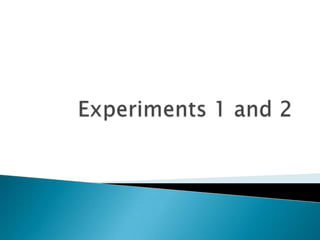
Experiments 1 and 2
- 2. Table 1–Baseline Blood Pressure Systolic pressure Diastolic pressure Mean arterial pressure (mm Hg) (mm Hg) (mm Hg) 151 81 98 Table 2–Blood Pressure Response to Cold Systolic pressure Diastolic pressure Mean arterial pressure (mm Hg) (mm Hg) (mm Hg) 134 73 90 Table 3 Heart rate Time Condition (bpm) (s) Resting heart rate 77.87 Maximum heart rate 81.96 40.01 Rebound heart rate 77.84 180.2
- 3. 1. The systolic pressure, diastolic pressure, mean arterial pressure, and heart rate would increase because a fight or flight situation would release adrenaline; just like the cold stimulus did but on a larger scale. 2. 120-139/80-89, pre-hypertension 3. What was expected from the experiment was that the maximum heart rate would gradually increase to reach its max; however, in our data the max heart rate was reached immediately when he immersed his foot in the ice water. The physiologic mechanism that causes this increase is a sympathetic response which causes an increase in heart rate; however in our subject the sympathetic response wasn’t created because of many different variables about the subject that caused a higher resistance to the stress of the ice water.
- 4. 4. After the maximum heart rate the heart rate of the subject declined steadily until it reached his rebound heart rate. The minimum heart rate was when the subject was at rest then the max occurred when the stress was introduced. Therefore, once the stress was taken away (after max was reached) that the body would then begin to use mechanisms to maintain homeostasis. Once the body had achieved homeostasis the heart rate was back to his initial resting heart rate throughout the remainder of the experiment. 5. It took about 140 seconds for our subject’s heart rate to reach his rebound heart rate. This shows that his heart rate could increase faster through shock/stress but, when the mechanisms were trying to maintain homeostasis it takes them longer to get the body back to a normal heart rate.
- 5. Table 1–Baseline Blood Pressure Systolic pressure Diastolic pressure Mean arterial pressure Pulse (mm Hg) (mm Hg) (mm Hg) (bpm) 136 76 115 84 Table 2–Blood Pressure After Exercise Systolic pressure Diastolic pressure Mean arterial pressure Pulse (mm Hg) (mm Hg) (mm Hg) (bpm) 162 84 110 91 Table 3–Heart Rate Condition Resting heart rate (bpm) 84 Maximum heart rate (bpm) 91 Recovery time (s) 38
- 6. 1. The trends that occurred in systolic, diastolic, and mean arterial pressure is that they all increased as well as the pulse with exercise. The cardiac output with a stroke volume of 75 mL/beat is 6825, and with a stroke volume of 100 is 9100 mL/beat. So the change in cardiac output was 2275 mL/min. 2. The pulse increased because the heart rate is dramatically increasing because your body is working harder. 3. a) There is a lighter pulse because the walls are dramatically bigger. b) There is a heavier pulse because more blood is pumping out.
- 7. 4. The resting heart rate is 84. 91 is the maximum. Using this information we see there is a 7% increase. 5. Our maximum is lower than all the other groups in our class. We did not expect this because we thought everyone would have around the same heart rate. 6. Our recovery time is shorter than all the other groups in our class. We did expect this because our maximum heart rate was the lowest out of all the other groups. 7. This specific person at rest would have a slower heart rate and while exercising would have a faster heart rate. 8. We would administer a medicine that slows the heart rate down.
- 8. Through these two experiments we learned that if we introduce our subject to exercise or a stress that their heart rate will increase fairly quickly; however, the systems in our body that work to maintain homeostasis take a longer time to get our body back to a normal resting heart rate. This shows that our subject is fairly normal and his/her body homeostasis systems are functioning properly.